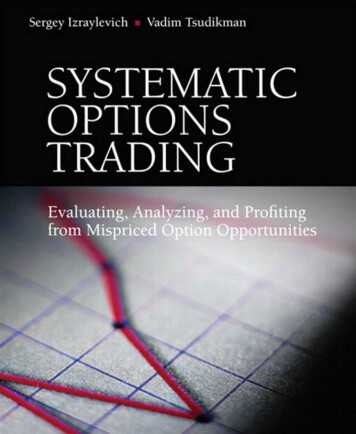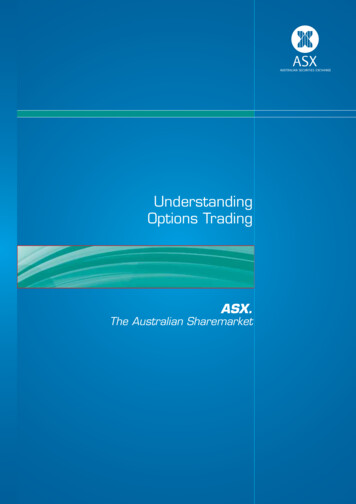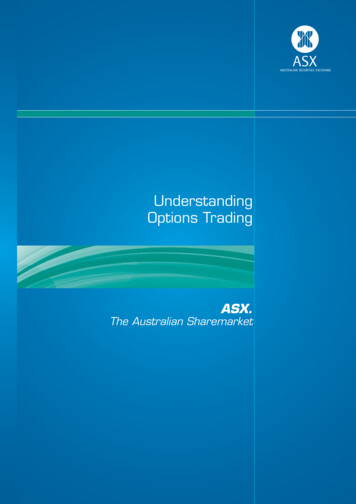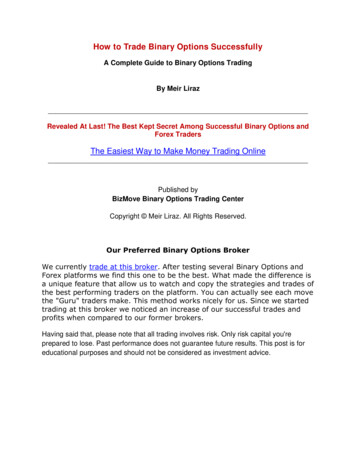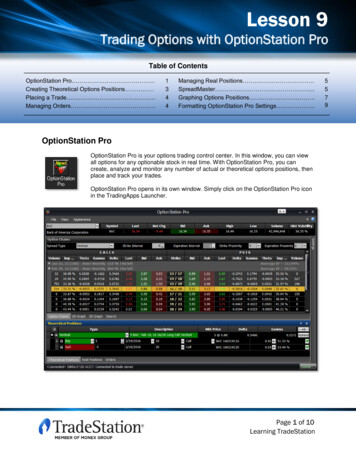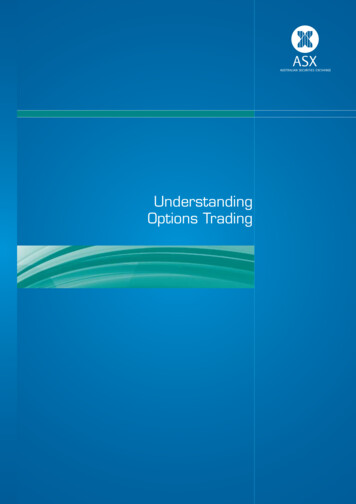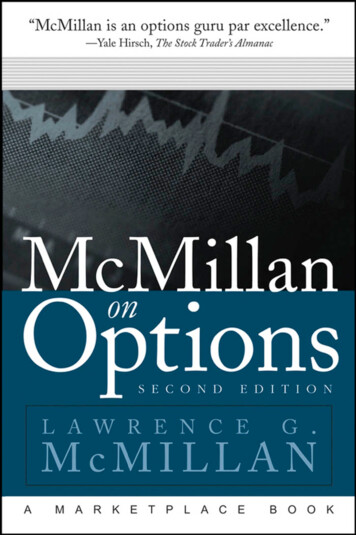
Transcription
McMillanon Options
Founded in 1807, John Wiley & Sons is the oldest independent publishingcompany in the United States. With offices in North America, Europe, Australia,and Asia, Wiley is globally committed to developing and marketing print and electronic products and services for our customers’ professional and personal knowledgeand understanding.The Wiley Trading series features books by traders who have survived the market’s ever-changing temperament and have prospered—some by reinventing systems, others by getting back to basics. Whether a novice trader, a professional, orsomewhere in-between, these books will provide the advice and strategies needed toprosper today and well into the future.For a list of available titles, visit our Web site at www.WileyFinance.com.
A MARKETPLACE BOOKMcMillanon OptionsSecond EditionLawrence G. McMillanJohn Wiley & Sons, Inc.
Copyright 2004 by Lawrence G. McMillan. All rights reserved.Published by John Wiley & Sons, Inc., Hoboken, New Jersey.Published simultaneously in Canada.No part of this publication may be reproduced, stored in a retrieval system, ortransmitted in any form or by any means, electronic, mechanical, photocopying,recording, scanning, or otherwise, except as permitted under Section 107 or 108of the 1976 United States Copyright Act, without either the prior writtenpermission of the Publisher, or authorization through payment of the appropriateper-copy fee to the Copyright Clearance Center, Inc., 222 Rosewood Drive,Danvers, MA 01923, 978-750-8400, fax 978-646-8600, or on the web atwww.copyright.com. Requests to the Publisher for permission should be addressedto the Permissions Department, John Wiley & Sons, Inc., 111 River Street,Hoboken, NJ 07030, 201-748-6011, fax 201-748-6008.Limit of Liability/Disclaimer of Warranty: While the publisher and author have usedtheir best efforts in preparing this book, they make no representations orwarranties with respect to the accuracy or completeness of the contents of thisbook and specifically disclaim any implied warranties of merchantability or fitnessfor a particular purpose. No warranty may be created or extended by salesrepresentatives or written sales materials. The advice and strategies containedherein may not be suitable for your situation. You should consult with aprofessional where appropriate. Neither the publisher nor author shall be liable forany loss of profit or any other commercial damages, including but not limited tospecial, incidental, consequential, or other damages.For general information on our other products and services, or technical support,please contact our Customer Care Department within the United States at 800762-2974, outside the United States at 317-572-3993 or fax 317-572-4002.Wiley also publishes its books in a variety of electronic formats. Some content thatappears in print may not be available in electronic books.For more information about Wiley products, visit our web site at www.wiley.com.ISBN 0-471-67875-9Printed in the United States of America.10 9 8 7 6 5 4 3 2 1
PrefaceWhen people learn that I have written another book, they usually askone of two questions: “Is this an update of your other book?” or“What’s the difference between this one and your other one?” Firstof all, this is most assuredly not an update of Options as a StrategicInvestment (OSI). This is a completely different, stand-alone bookthat relates option trading in actual examples. Second, there is a substantial difference between this book and OSI. This book is notintended to be a comprehensive definition of strategies—that is better derived from OSI, which is a reference work. This is a book inwhich the application of options to actual trading situations is discussed. There are plenty of actual trading examples, many of themderived from my own trading experience. In addition, there are anumber of stories—some humorous, some more on the tragic side—that illustrate the rewards and pitfalls of trading, especially tradingoptions. In addition, the content of this book covers ground that onedoes not normally find in books on options; that content will be discussed shortly.There is a continuous discussion of futures trading, as well asstock and index trading, herein. The futures markets offer manyinteresting situations for option trading and strategies. To that end,the basic definitions of futures options—and how they compare to,and differ from, stock options—are included in Chapter 1.While the book is not really meant for beginners, it contains allthe necessary definitions. Thus, serious traders will have no trouble atall in getting up to speed. In fact, many of the techniques described inthis book do not require familiarity with option strategies at all. Themore elementary option strategy definitions are not expanded uponv
viPREFACEat great length here, however, as my objective is to describe practicalapplications. For example, it is not my intention to detail the explicitcalculations of break-even points and explain follow-up actions forthese basic strategies. Readers who feel a need to better understandthe basics should refer to the aforementioned work, OSI, whichdescribes virtually all conceivable strategies in a rather large amountof detail.As for content, the book is basically divided into five major sections, spread out over seven rather lengthy chapters. The first part—Chapters 1 and 2—lays out the basic definitions and reviews optionstrategies, so that the framework is in place to understand and utilizethe material in succeeding chapters. Even seasoned option professionals should enjoy reading these introductory chapters, for thetrading tales that accompany many of the strategies are sure to elicitsome nodding of heads. Graphs and charts are liberally used. Sincethings are more easily seen in graphs than in tables, over 120 suchgraphs and charts are included in this book.The next three chapters—3 through 5—are intensive discussionsof some very important trading tactics, based on options. However,they are more of a basic nature and don’t require a theoreticalapproach to option trading. In fact, a stock or futures trader shouldbe able to absorb this information rather quickly, even if he doesn’thave a clue as to what the delta of an option is. Don’t get mewrong—I encourage every option trader to use a model via a computer program in order to evaluate an option before he actually buysor sells it. However, these chapters don’t require anything more theoretical than that.Chapter 3 contains material that is extremely important to alltraders—particularly stock traders, although futures traders will certainly benefit as well. I like to think of the information in this chapteras demonstrating how versatile options can be—they don’t have tobe merely a speculative vehicle. A basic understanding of the concepts involving using options to construct positions that are equivalent to owning stock or futures contracts is shown to be necessary formany applications. For example, it allows a futures trader to extracthimself from a position, even though the futures may be locked limitagainst him.
PREFACEviiLater in the same chapter, there is an extremely detailed discussion of how the expiration of options and futures affect the stockmarket. Several trading systems are laid out that have good trackrecords, and that can be used month after month. Finally, the use ofoptions or futures to protect a portfolio of stocks is also discussed insome detail. If we ever go into another bear market, these strategieswill certainly become very popular.Chapter 4 is my favorite—“The Predictive Power of Options.”Since options offer leverage, they are a popular trading vehicle for allmanner of speculators. By observing both option prices and optionvolume, you can draw many important conclusions regarding theforthcoming direction of stocks and futures. A large part of the chapter describes how to use option volume to buy stock (or sometimessell it) in advance of major corporate news items, such as takeoversor earnings surprises. However, another lengthy discussion involvesthe put–call ratio—a contrary indicator—as it applies to a wide variety of indices and futures. The work on futures’ put–call ratios is, Ibelieve, unique in the annals of technical analysis in that the techniques are applied to and rated on a vast array of futures markets.Several trading systems—from day-trading to seasonal patterns—with profitable track records are described in Chapter 5.Many traders, even those who are technically inclined, often overlook the power of seasonality. Moreover, the use of options in intermarket spreads is explained. Options give intermarket spreaders anadditional chance to make money, if applied in the ways shown.For those with a theoretical bent, Chapter 6 may be your favorite.The use of neutral option strategies is discussed, especially withrespect to predicting and trading volatility. One of my pet peeves isthat the term “neutral” is thrown around with such ease and, as aresult, is often applied to positions that have considerable risk. Theintent of Chapter 6 is to not only set the record straight, but todemonstrate that—while neutral trading can certainly be profitable—it is not the easy-money, no-work technique that some proponentsseem to be extolling. I am often asked how I base my decisions ontaking a position, rolling, and so forth, so the backspread example inChapter 6 is intended to be almost a diary of what I was thinking andhow I traded the position over the course of six months.
viiiPREFACEThe book winds up with a discussion of money management,trading philosophy, and some trading guidelines—all in Chapter 7.Some of my favorite trading stories and sayings are related in thischapter. I hope you enjoy them as well.My hope is that this book will bring more traders into the optionmarkets, as they realize that options can be used in many ways.Options don’t merely have to be treated as a speculative vehicle. Infact, you might be strictly a stock or futures trader but find thatoptions can give you valuable buy and sell signals. Those with a moretheoretical bent will find that volatility trading can be lucrative as well.SECOND EDITIONAfter seven years, I felt a second edition was necessary because therehad been sufficient changes in the derivatives industry to justify arewrite with deletions and additions. For example, Chapter 1, whichis mostly definitions, now includes Exchange Traded Funds, ElectronicTrading, Single Stock Futures, and Volatility Futures. The main purpose of the second edition is to weed out material that no longer isviable—either because products had become delisted or illiquid orbecause strategies had become exploited—and to include new tacticsand strategies that I apply in my own trading and analysis.Chapter 3, which discusses various option special applications,now includes a discussion describing how a stock can be “pinned” toa striking price at expiration—what causes it, why it happens, andwhen to expect it. Furthermore, as options have become more popular as a hedging vehicle for stock owners—particularly professionalstock owners—new strategies have developed. They are included inthis new edition. One is the use of the newly listed volatility futures,and another is an expanded use of the “collar” strategy with listedoptions. New examples are included to describe both applications.In the revised Chapter 4, one major addition is the inclusion ofput–call ratio charts and theory on individual stocks. In the first edition, I had felt that there was too much insider trading in stockoptions and that such activity would distort the usefulness of put–callratios on individual stocks. But, as time passed, I came to feel thatlarge, well-capitalized stocks were less susceptible to manipulation
PREFACEixand insider trading and that their put–call ratios could indeed provideanother good sentiment-based indicator for traders. Another majoraspect of put–call ratios included in this edition is weighted put–callratios. This method, which incorporates the price of the option aswell as its trading volume, is a highly effective improvement on thebasic theory of using put–call ratios as indicators. On another relatedtopic—using the volatility indices as a market predictor—we havedone a good deal of research over the years, and much of that is nowincluded in Chapter 4. This research not only includes the analysis ofpeaks and valleys in the VIX chart itself, but also shows how the comparison of implied and historical volatilities is an important indicator.Chapter 5 still covers trading systems and strategies. One majorchange that has taken place in the markets in recent years is the lossof effectiveness of the New York Stock Exchange (NYSE) advance–decline figures. This is due to decimalization for the most part. As aresult, we have adapted another method of looking at breadth—the“stocks only” approach. This adaptation is applied to some of oursystems, and the improvement is significant. The section on intermarket spreads has been updated as well. For some spreads, this isnothing more than bringing charts up to date. But for others—notably, the January effect spreads—significant changes in the pattern of the spread have taken place; and, thus, changes in strategyfor trading the spread are necessary as well. This also includes theway that intermarket spreads are implemented. There is less relianceon futures and more reliance on Exchange Traded Funds (ETFs),which are much more popular now than they were when the first edition was published. Finally, the seasonal trading systems are updated,and one more has been added—the late-January seasonal buy point.The systems presented in this chapter remain some of my favoritespeculative trading vehicles; and with this new, up-to-date information, they should prove to be useful for all readers.A more advanced approach to option trading is once again presented in Chapter 6. A significant
options or futures to protect a portfolio of stocks is also discussed in some detail. If we ever go into another bear market, these strategies will certainly become very popular. Chapter 4 is my favorite—“The Predictive Power of Options.” Since options offer leverage, they are a popular trading vehicle for all manner of speculators. By observing both option prices and option
